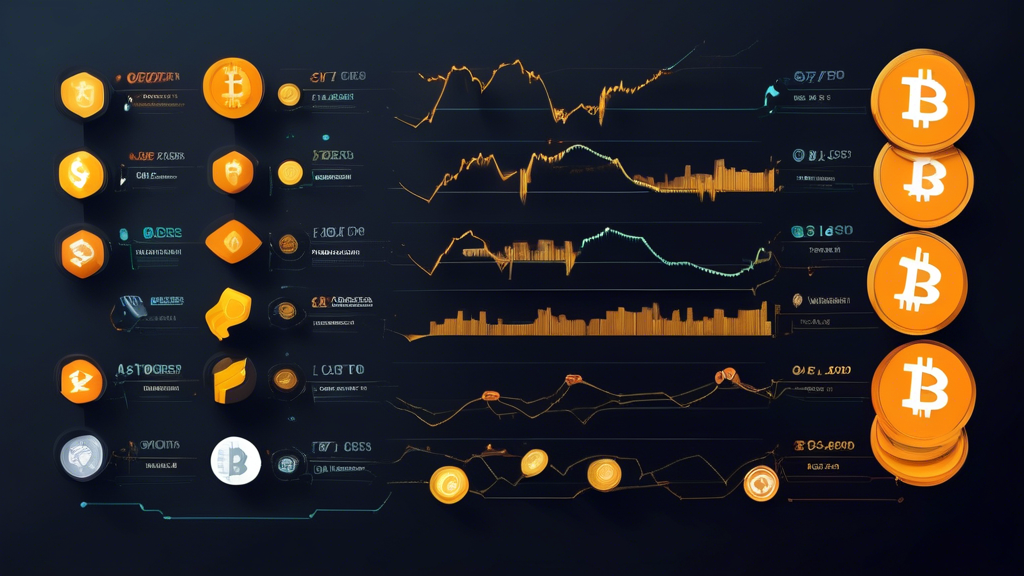Comparing Forex Trading and Cryptocurrency: Key Differences and Strategies
Understanding the Basics: Forex Trading vs. Cryptocurrency
In the ever-evolving landscape of financial markets, two prominent avenues have captured the interest of traders and investors alike: forex trading and cryptocurrency. Each market offers unique opportunities and challenges, making it crucial to understand their fundamental differences and strategic approaches. This article dives into a comprehensive comparison of forex trading and cryptocurrency, highlighting essential elements such as market structure, accessibility, regulations, and more. Whether you’re a seasoned trader or new to these markets, gaining insights into their distinctive characteristics will empower you to make informed trading decisions.
Forex trading, or foreign exchange trading, involves the buying and selling of currencies on a decentralized global market. Known for its substantial market size, forex trading attracts key players such as governments, financial institutions, corporations, and individual traders. On the other hand, cryptocurrency refers to digital or virtual currencies employing cryptography for security. Notable cryptocurrencies like Bitcoin and Ethereum have surged in popularity, contributing to a rapidly expanding market size.
One significant difference between these markets lies in their accessibility and operating hours. While the forex market operates 24 hours a day, five days a week, cryptocurrency markets offer round-the-clock trading—all year long. This continuous availability of crypto trading appeals to those seeking flexibility beyond traditional market hours.
When it comes to the legal landscape, forex trading generally operates under a more regulated environment with established regulatory bodies such as the Financial Conduct Authority (FCA) in the UK and the Commodity Futures Trading Commission (CFTC) in the US. Cryptocurrency regulations, however, are still evolving, with varying degrees of acceptance and oversight across different jurisdictions.
Understanding the Basics: Forex Trading vs. Cryptocurrency
Introduction to Forex Trading
Forex trading, short for foreign exchange trading, involves the buying and selling of currencies. It’s the largest and most liquid market in the world, with a daily trading volume exceeding $6 trillion. The forex market operates through a global network of banks, brokers, and financial institutions. Key players in this market include central banks, commercial banks, financial institutions, hedge funds, corporations, and individual retail traders. The primary objective of forex trading is to profit from changes in the value of one currency relative to another.
Introduction to Cryptocurrency
Cryptocurrency is a digital or virtual form of currency that uses cryptography for security. Unlike traditional currencies issued by governments (fiat currencies), cryptocurrencies operate on decentralized networks based on blockchain technology. The most notable cryptocurrencies include Bitcoin (BTC) and Ethereum (ETH), among thousands of others. The market cap of all cryptocurrencies combined is substantial, though it fluctuates widely due to market volatility. Cryptocurrencies can be used for various purposes, from online purchases to investments and remittances.
Market Accessibility and Hours
One of the key differences between forex trading and cryptocurrency is market accessibility and operating hours. The forex market is typically open five days a week, 24 hours a day. It follows a global time zone system, allowing traders to access the market from Sunday evening through Friday evening (Eastern Standard Time). This accessibility is facilitated by major forex trading hubs such as London, New York, Tokyo, and Sydney.
In contrast, the cryptocurrency market is available 24/7, 365 days a year. This constant availability allows traders to execute transactions at any time, providing greater flexibility compared to the forex market. However, this can also result in continuous exposure to market volatility, requiring traders to be vigilant around the clock.
Regulations and Legal Landscape
Regulations play a significant role in the trading environment of both forex and cryptocurrencies, although the regulatory landscapes differ considerably. The forex market is highly regulated, with oversight from government and financial authorities such as the Commodity Futures Trading Commission (CFTC) in the United States, the Financial Conduct Authority (FCA) in the United Kingdom, and other similar bodies around the world. These regulations aim to ensure market integrity, protect investors, and reduce the risk of fraud.
On the other hand, the legal landscape for cryptocurrencies is still evolving. While some countries have established clear regulations, others grapple with creating frameworks to govern this relatively new industry. In some regions, cryptocurrencies are banned or heavily restricted, while others have embraced them and introduced regulations to manage and control their use. The decentralized nature of cryptocurrencies poses a unique challenge for regulatory bodies, leading to ongoing discussions and changes in the regulatory environment.
In sum, understanding the basic differences between forex trading and cryptocurrency is crucial for anyone considering entering these markets. Whether it’s the well-established, regulated nature of forex or the innovative, 24/7 world of cryptocurrency, each market offers its unique set of attributes, opportunities, and challenges.
Volatility and Market Behavior: Analyzing Forex Trading and Cryptocurrency
Price Volatility
When comparing forex trading and cryptocurrency, one of the most striking differences lies in their price volatility. The forex market is known for its relative stability, reflecting the economic conditions and monetary policies of the countries involved. Major currency pairs such as EUR/USD or USD/JPY tend to exhibit lower volatility compared to cryptocurrencies.
In contrast, the cryptocurrency market is notorious for its high volatility. Prices of cryptocurrencies like Bitcoin, Ethereum, and other altcoins can fluctuate wildly within short periods. This immense volatility can be attributed to the relatively smaller market size and lower liquidity compared to the forex market. For traders, this volatility offers both opportunities for high returns and significant risks.
Market Influencers
The factors influencing forex and cryptocurrency markets are distinct, further delineating their differences. In the forex market, currency values are affected by a broad spectrum of economic indicators, including interest rates, inflation data, employment figures, and GDP growth. Geopolitical events, central bank policies, and global trade dynamics also play crucial roles in shaping forex rates.
On the other hand, cryptocurrency prices are predominantly driven by market sentiment, technological developments, and regulatory news. For instance, announcements regarding the adoption of blockchain technology, hacks, or changes in legal frameworks can cause substantial price swings. Additionally, the actions of large holders—or whales—and trends in investor sentiment can have outsized impacts on cryptocurrency valuations.
Technical Analysis Tools
Despite these differences, traders in both markets employ similar technical analysis tools to inform their strategies. Three commonly used indicators are:
- Moving Averages: This tool helps traders identify the direction of the trend by smoothing out price data. In both forex and cryptocurrency, traders use simple moving averages (SMA) and exponential moving averages (EMA) to make decisions.
- Relative Strength Index (RSI): RSI measures the magnitude of recent price changes to evaluate overbought or oversold conditions. An RSI above 70 typically indicates an overbought market, while an RSI below 30 suggests an oversold market.
- Moving Average Convergence Divergence (MACD): This tool indicates momentum by comparing short-term and long-term moving averages. It’s widely used by forex and cryptocurrency traders to detect bullish or bearish signals.
While these tools are popular across both markets, the effectiveness and interpretation of these indicators may differ due to the unique characteristics of each market. For instance, the high volatility of cryptocurrencies might lead to more frequent false signals in technical analysis as compared to the more stable forex market.
Strategizing for Success: Effective Tactics in Forex Trading and Cryptocurrency
Trading Strategies for Forex
Success in forex trading largely depends on applying the right strategies suited to the trader’s goals and market conditions. Some of the most effective strategies include scalping, day trading, and swing trading.
Scalping
Scalping is a high-frequency trading strategy that involves making multiple trades within a day to capitalize on small price movements. It requires quick decision-making and a strong grasp of technical analysis. Scalpers aim to profit from small pips, cumulatively adding up significant gains over time. The core tools for scalpers include tight spreads, fast execution, and advanced charting software.
Day Trading
Day trading involves buying and selling currency pairs within the same trading day. This strategy focuses on profiting from daily price fluctuations and avoids the risks associated with overnight positions. Day traders typically rely on short-term technical analysis and indicators such as moving averages, Bollinger Bands, and the Relative Strength Index (RSI). Consistency and discipline are crucial for day trading success.
Swing Trading
Swing trading spans over a more extended period, from a few days to several weeks. This strategy aims to profit from expected price movements and trends over a longer timeframe. Swing traders use both technical and fundamental analysis to identify growth opportunities. Commonly used tools include trend lines, Fibonacci retracements, and moving average crossovers. This approach is less intensive than scalping or day trading, making it suitable for those with other commitments.
Trading Strategies for Cryptocurrency
Cryptocurrency markets offer unique opportunities and challenges, different from forex trading. Here are some popular strategies for successfully navigating the crypto landscape: HODLing, arbitrage, and Initial Coin Offerings (ICOs) investments.
HODLing
HODLing (Hold On for Dear Life) is a long-term investment strategy where traders buy cryptocurrencies and hold them regardless of short-term market volatility. This tactic relies on the belief that the value of cryptocurrencies will appreciate significantly over time. HODLers focus on established cryptocurrencies like Bitcoin and Ethereum, keeping their investments intact through market fluctuations.
Arbitrage
Arbitrage involves buying a cryptocurrency from one exchange where the price is lower and simultaneously selling it on another exchange where the price is higher. This strategy takes advantage of price discrepancies between different trading platforms. Arbitrageurs must act quickly and efficiently to exploit these opportunities due to the fast-paced nature of cryptocurrency markets. Advanced trading bots and analytical tools are often employed to identify and execute arbitrage opportunities.
ICO Investments
Initial Coin Offerings (ICOs) are a fundraising mechanism where new cryptocurrencies are offered to investors before they hit the broader market. Successful ICO investments can yield high returns if the project gains traction post-launch. However, this strategy is fraught with risk due to the prevalence of fraudulent schemes and unsuccessful projects. Investors need to conduct thorough due diligence and assess the legitimacy and potential of each ICO.
Risk Management Techniques
Regardless of the market or strategy, risk management is a cornerstone of successful trading. Here are some essential techniques that apply to both forex and cryptocurrency trading:
Stop-Loss Orders
Stop-loss orders are pre-set instructions to sell an asset when it reaches a certain price level. This tool helps limit potential losses by automatically exiting a position before losses escalate. Setting appropriate stop-loss levels based on market analysis and risk tolerance is critical for safeguarding capital. Both forex and cryptocurrency traders should consistently employ stop-loss orders to mitigate risk.
Portfolio Diversification
Diversification involves spreading investments across various assets to reduce exposure to any single investment’s risk. In forex trading, this may include trading in multiple currency pairs. For cryptocurrency traders, diversification can mean holding a mix of different coins, including established ones like Bitcoin and up-and-coming altcoins. Diversifying helps cushion the impact of adverse price movements in a particular asset.
The Role of Leverage
Leverage allows traders to control larger positions with a smaller amount of capital. While leverage can amplify profits, it can also magnify losses, making its judicious use essential. Forex markets frequently offer leverage, sometimes up to 100:1 or higher. Cryptocurrencies also provide leverage but usually at a lower ratio. Traders must understand leverage’s implications and use it within their risk capacity.
Emerging Trends and Future Outlook
Technological advancements and market developments continually shape the trading landscape for both forex and cryptocurrency markets. Here are some emerging trends to watch:
Impact of Technological Advancements
Technology plays a vital role in modern trading. In forex trading, the advent of automated trading systems and artificial intelligence (AI) has revolutionized the market. These tools can analyze vast amounts of data at lightning speed, offering traders new insights and efficiencies. Cryptocurrency trading also benefits from technological innovations, including blockchain technology, which enhances security and transparency. Additionally, decentralized finance (DeFi) platforms are gaining traction, offering new trading and investment opportunities.
Market Developments
The forex market continues to evolve with global economic shifts and regulatory changes. Similarly, the cryptocurrency market is undergoing significant transformation due to the increasing acceptance of digital currencies by mainstream financial institutions and governments. Regulatory frameworks are becoming more defined, which could lead to greater stability and broader adoption of cryptocurrencies. Traders in both markets must stay informed about these developments to adapt their strategies accordingly.
In conclusion, while forex trading and cryptocurrency share some similarities, they also exhibit distinct differences. Understanding these differences and employing appropriate strategies and risk management techniques can enhance one’s chances of success in either market.
Conclusion
In conclusion, forex trading and cryptocurrency trading present distinct opportunities and challenges for traders. Understanding the fundamental differences between these two markets is crucial for crafting effective trading strategies. The forex market, with its long-established history, provides a relatively stable environment influenced by macroeconomic factors and geopolitical events. In contrast, the cryptocurrency market, characterized by its high volatility and nascent regulatory landscape, demands a more agile and speculative approach.
Both markets offer round-the-clock trading, though cryptocurrency’s 24/7 availability may appeal more to those who prefer constant market access. While the forex market’s technical analysis tools can be readily applied to cryptocurrencies, the latter’s unique market influencers necessitate a keen awareness of emerging trends and regulatory changes.
Strategically, the choice between forex and cryptocurrency trading will depend on the trader’s risk tolerance, investment goals, and market insights. Effective risk management, whether through stop-loss orders or portfolio diversification, remains foundational in both arenas. As technological advancements continue to shape the landscape, staying informed about market developments will be key to navigating these dynamic and potentially rewarding markets.
By leveraging the insights and strategies discussed, traders can better position themselves for success in both forex and cryptocurrency trading. As the financial world evolves, the ability to adapt and capitalize on new opportunities will distinguish successful traders from the rest.



